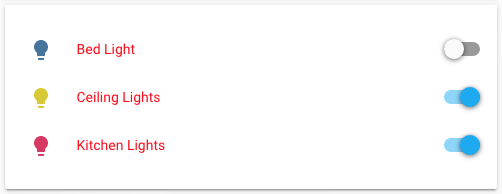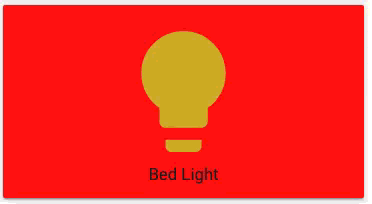Allows you to add css styles to any lovelace card.
For installation instructions see this guide.
Install card-mod.js as a module.
resources:
- url: /local/card-mod.js
type: moduleThis is not a new card. Instead it changes the way pretty much any other card works.
Specifically, it looks for style: in any cards configuration, and applies the CSS specified there to the card.
The basis of almost all lovelace cards is a ha-card element, so that's probably where you'd want to start.
Note that some cards (conditional, entity-filter, horizontal-stack and vertical-stack as well as some custom cards, like layout-card, auto-entities and state-switch among others) do not have a ha-card element, and card-mod will thus not work for those. There is a workaround, though. See mod-card below.
Example:
Change the text color of an entities card to red.
type: entities
style: |
ha-card {
color: red;
}
entities:
- light.bed_light
- light.ceiling_lights
- light.kitchen_lightsBy using the element inspector of your browser (chrome, firefox, safari, explorer) you can find out how cards are built up and what styles they are using.
Example
Make a glance card use smallcaps and change the font size of the title
type: entities
style: |
ha-card {
font-variant: small-caps;
}
.card-header {
font-size: 16px;
}
entities:
- light.bed_light
- light.ceiling_lights
- light.kitchen_lightsYou can also use templating to change the styles dynamically.
Example
Make an entity-button card green when the light is on
type: entity-button
entity: light.bed_light
style: |
ha-card {
background: {% if is_state('light.bed_light', 'on') %} green {% endif %};
}Anything you add in style: will be put in a <style> tag, so you can also use things like css keyframes
Example
Make a blinking button
type: entity-button
entity: light.bed_light
style: |
@keyframes blink {
50% {
background: red;
}
}
ha-card {
animation: blink 2s linear infinite;
}More examples are available here.
To make things easier, rows in entities cards and buttons in glance cards can be styled individually.
For those, the styles will be applied to the shadowRoot of the element, so a good starting point (rather than ha-card) would be :host:
type: entities
entities:
- light.bed_light
- entity: light.kitchen_lights
style: |
:host {
color: red;
}
- entity: input_number.value
style: |
:host {
--paper-item-icon-color:
{% if states(config.entity)|int < 50 %}
blue
{% else %}
red
{% endif %}
;
}Badges can be styled too, with the base style applied to :host.
Note that to change the color of a badge, you need to override the variable for it's default color. I.e. the badges in the example below are normally red, thus the --label-badge-red variable is set.
badges:
- entity: sun.sun
name: Original
- entity: sun.sun
style: |
:host {
--label-badge-red: purple;
}
name: Purple
- entity: sun.sun
name: Teal
style: |
:host {
--label-badge-red: teal;
}
- entity: sun.sun
name: Dashed
style:
ha-state-label-badge:
$:
ha-label-badge:
$: |
.label-badge {
border-style: dashed !important;
}Jinja templates have access to a few special variables. Those are:
config- an object containing the card, entity row or glance button configurationuser- the username of the currently logged in userbrowser- the deviceID of the current browser (see browser_mod).hash- the hash part of the current URL.
When exploring the cards using the element inspector, you might run into something called a shadow-root and notice that you can't apply styles to anything inside that.
In this case, you can make style: a dictionary instead of a string, where each key is a querySelector string and it's value styles to apply to it - recursively. A key of $ means go into a shadow-root and a key of . the current element.
This is not for the faint of heart.
For some extra help, add debug_cardmod: true to the card config, and the steps taken to apply the styling will be printed in the browser console. It can be removed later.
Example:
Change some things in an alarm-panel card.
type: alarm-panel
card_icon: mdi:bell
name: Alarm Panel
debug_cardmod: true
style:
.: |
ha-card {
--mdc-theme-primary: red;
}
"#keypad mwc-button":
$: |
:host {
background: blue;
}
button {
font-size: 24px !important;
}
"#keypad mwc-button:nth-of-type(12)":
$: |
button {
font-size: 16px !important;
--mdc-theme-primary: green;
}
entity: alarm_control_panel.alarm** IMPORTANT: *** mod-card is a workaround for the very few cases where normal usage of card-mod does not work.
I cannot stress this enough (apparently). If you every find yourself typing type: custom:mod-card, stop, go back, read this readme all the way through again, and realized that in approximately 10 out of 10 cases, you should NOT use mod-card.
There are some cards where card-mod just won't work.
Those cards often are not really cards at all, but change how other cards work. Examples include: conditional, entity-filter, horizontal-stack and vertical-stack as well as some custom cards, like layout-card, auto-entities and state-switch among others.
For those cases, a special mod-card is provided as a workaround:
type: custom:mod-card
style: |
ha-card {
border: 1px solid green;
}
card:
type: vertical-stack
cards:
- type: light
entity: light.bed_light
- type: light
entity: light.kitchen_lightsNote: mod-card sets it's own
backgroundtotransparent. That means,--ha-card-backgroundwill have no effect on mod-card itself. Instead, you ahve to modify thebackgroundproperty directly.
Mod-card also allows you to manually specify a cardHeight of a card. This can be used to slightly modify the behavior of the layout engine of lovelace. See this description for details.
The cardHeight is set with the report_size: option:
type: custom:mod-card
report_size: 5
card:
... etc ...For cards, you just have to wrap everything in ha-card {} and format it as CSS.
And don't forget to remove (not replace with anything else) card-modder.
So, you go from:
type: custom:card-modder
card:
type: entities
entities:
- light.bed_light
style:
"--ha-card-background": rgba(200, 0, 0, 0.5)
color: whiteto
type: entities
entities:
- light.bed_light
style: |
ha-card {
--ha-card-background: rgba(200, 0, 0, 0.5);
color: white
}For rows in an entities card, you replace ha-card with :host as described above.









